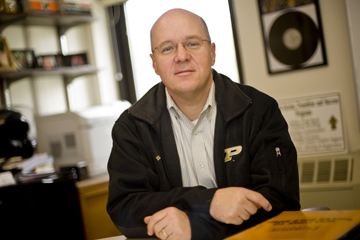Purdue Profiles: Dan Carpenter

Dan Carpenter, associate director of Purdue's Student Access, Transition and Success (SATS) Programs Department. (Purdue University photo/Andrew Hancock)
Nothing is more rewarding to Dan Carpenter than watching the success of those he's helped through Purdue's Student Access, Transition and Success (SATS) Programs Department.
Carpenter, as associate director of SATS, helps students prepare for, navigate and achieve during their studies at Purdue. A 22-year U.S. Army veteran and the former head of Purdue's Army Reserve Officer Training Corps (ROTC) program, Carpenter brings a special brand of leadership and compassion to his job.
What is your Army background?
I began a career in the regular Army in 1986 after being in ROTC in college at Northern Illinois University. I really wanted an opportunity to serve my country, and I wanted to pursue something that would give me a sense of adventure. Throughout my Army career I was stationed all over the world, including in Europe, Afghanistan, Uzbekistan and Saudi Arabia.
In 2004, I was assigned to Purdue as head of the Army ROTC program. It was a great fit; since I came from an ROTC background, I had hoped one day to become involved in the program again. I ended up retiring from the Army in 2008, after that final assignment. I began my SATS role shortly afterward.
What are your daily duties related to the SATS programs?
Among other things, I'm responsible for the orientation programs, which include Boiler Gold Rush and Summer Transition Advising and Registration (STAR). My office helps coordinate BGRi, or Boiler Gold Rush International, which is a pre-orientation program for international students. That's a joint effort through the Office of International Students and Scholars, University Residences and SATS.
Several other things also fall under my umbrella, including the University's learning communities. Those typically are groups of 20 to 30 first-year students who either take two courses together or live together or do both. We coordinate the learning communities for the University while dedicated faculty and staff actually run them. We coordinate all the logistics such as the planning, recruitment and placement.
I'm also responsible for Supplemental Instruction, which is a form of peer-led academic assistance. With that, we identify outstanding students in gateway or early transition courses with large enrollment and in which students typically struggle. We recruit, select and train those outstanding students, and we pay them to lead study sessions in future sections of that course. It's a fantastic way to help students understand course concepts, gain study skills and improve their academic performance.
How did you become interested in pursuing a job with SATS?
When I started thinking about what I wanted to do when I retired from the Army, it didn't take me long to realize that I wanted to continue to work in higher education, and I wanted to do it right here at Purdue. I really enjoy being here and living here, and I love working with the students. To me, this position offered the opportunity to continue to pursue my career goal, which is to try to have a positive impact on young adults. I love being able to work with them as they make decisions about their future lives.
How has your Army experience informed the way you approach your current job?
In ROTC, I would set the vision and the strategy for how we ensured we achieved our desired outcomes of student success. That's very similar to what I do here. I work with excellent colleagues who run our programs, and that allows me to help them establish our vision, provide them with support, help them think ahead and push them to improve our programs. We have a very broad impact across the student body; that's the fun of what we do.
Watching students find their way here at Purdue and become successful is, to me, the most rewarding thing about my job. A lot of what we do is very broad, but sometimes I run into reminders about our effects on students. Sometimes, I hear students say that if it weren't for Supplemental Instruction or their learning community, they never would have made it academically. That sort of feedback from our day-to-day work is great to hear.
What are some new initiatives coming out of the SATS programs?
We're working to expand the learning communities. Until two years ago, the University had 49 learning communities, which could include about 1,400 students. Then, Tim Sands, Purdue's executive vice president for academic affairs and provost, saw the value of learning communities in fulfilling the University's strategic plan. He directed us to expand. So in the course of the last two years, we've been working with faculty and staff around the University to develop new or expanded learning communities.
We had an expanded offering this past fall of 66 learning communities. For fall of 2012, there will be more than 80, with more than 2,500 seats available. That's nearly double what we had two years ago. It's a really exciting thing.
